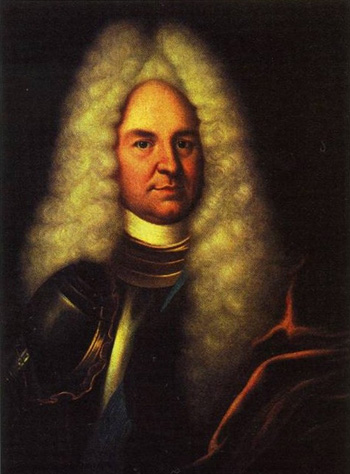Scottish mercenary and Russian general. Patrick Leopold Gordon was born May 31, 1635, to a Scottish Catholic family. His ancestors were ennobled for supporting King James II of Scotland in 1449, but during the English Civil War (1642- 1649) the family fell out of favor. Patrick Gordon therefore left for Danzig in 1650. He lived briefly in Braunsberg before studying at the Jesuit College at Frauenberg. Gordon left school in 1654, and enlisted as a cavalryman in the Swedish army.
Gordon served briefly under Field Marshal Arvid Wittenberg before joining the infantry regiment of Count Pontus de la Garie. Gordon was captured by the Poles at Rimanova in 1655, but released when he promised to enlist as a dragoon under Polish commander Constantine Lubomirski. During the siege of Warsaw in July 1656, however, Gordon was taken prisoner by Brandenburgers. They brought him to their Swedish commander, General Field Marshal Lieutenant Duglas, who freed him on condition that he serve again in the Swedish army. Duglas had formed a company of Scots as a sort of officers’ school, and Gordon remained an instructor there, seeing occasional action around Danzig, until January 1657.
Gorden then was taken prisoner again by the Poles but released as part of a prisoner exchange. Gordon thus returned to Duglas’s unit and served near Strasbourg, where he was captured by a Habsburg unit. Gordon escaped and was released from Swedish ser vice on January 1, 1658. Gordon then joined another Swedish unit but was captured by the Poles during an action near Thorn (Torun). The Poles refused to release him, and Gordon refused to switch sides until Lubomirski offered him a post as regimental quartermaster.
Here Gordon was noted for his industry and decisiveness; he was promoted to captain lieutenant and returned to the field in 1660. Avoiding capture, he fought against Russians and Cossacks on the Hungarian border and in Volhynia. Gordon was deco rated several times for actions in battles at Lubar, Slobodischtsche, and Czudno. He then sought his release from service, intending to return to Scotland. When the Russian ambassador to Poland offered him a post as a major with the promise of promotion to colonel within two years, however, Gordon entered the czar’s service. He departed for Moscow on September 2, 1661, as part of a regiment of foreign mercenaries.
In January 1665, only days after his marriage to the 17- year-old daughter of Colonel Philipp Albrecht von Brockhoven, Gordon was promoted to colonel. From June 1666 to February 1667, he served as the czar’s representative in London. Gordon then served in regiments in Sloboda, Briansk, Trubestchov, Sevsk, Kanev, and Periaslav until 1677, defending against Tatar incursions and suppressing the occasional Cossack rebellion. In August 1678, Gordon supervised the fortification of Chigirin against the Turks. Even though the city had to be abandoned after four weeks, Gordon was promoted to major general and posted to Kiev. He advanced to lieutenant general in 1683, but remained generally unhappy in Russian service. The czar did allow Gordon to visit England in January 1686; however, Gordon’s family was to remain in Russia as a sign of good faith.
In August 1686, Gordon presented the Regent Sophia with letters from King James II of England naming Gordon his representative to Russia and therefore requesting Gordon’s release. Threatened with demotion and a remote posting, Gordon recanted and accepted a command at his former rank. He led a regiment in two campaigns against the Turks (1687 and 1689); in both cases, Prince Vasily Golitsyn, the commander in chief, marched his armies to the Dnieper River, declared the campaign impossible, and returned home. Gordon nonetheless was rewarded richly and allowed to settle in Moscow, where he took command of one of the foreign regiments established as a training ground for officers.
Here Gordon befriended the future Peter I and, along with several other foreign officers, sided with Peter against his co- czar Sophia. Gordon accompanied Czar Peter on a journey to Archangelsk in 1694, and served as his representative to the Holy Roman Empire in early 1695; he planned and participated in the Azov campaigns of 1695- 1696. During Peter’s “Great Embassy” of 1697- 1698, Gordon served as second in command of military administration and supervised the fortification of Taganrog. Gordon also played a pivotal role in suppressing the revolt of the streltsy, an elite unit that rose in support of Sophia and against Peter in June 1698. He became ill shortly thereafter, however, and died in Moscow on November 29, 1699. Peter I provided him with a lavish funeral, which included an oration from the grateful czar.
Further Reading Bushkovich, Paul. Peter the Great: The Struggle for Power, 1671- 1725. Cambridge: Cambridge University Press, 2001. Fedosov, Dmitri, ed. The Diary of General Patrick Gordon of Auchlauchries, 1635- 1699. 2 vols. Aberdeen: University of Aberdeen, 2009. Hughes, Lindsey. Russia in the Time of Peter the Great. Cambridge, MA: Harvard University Press, 1998.
